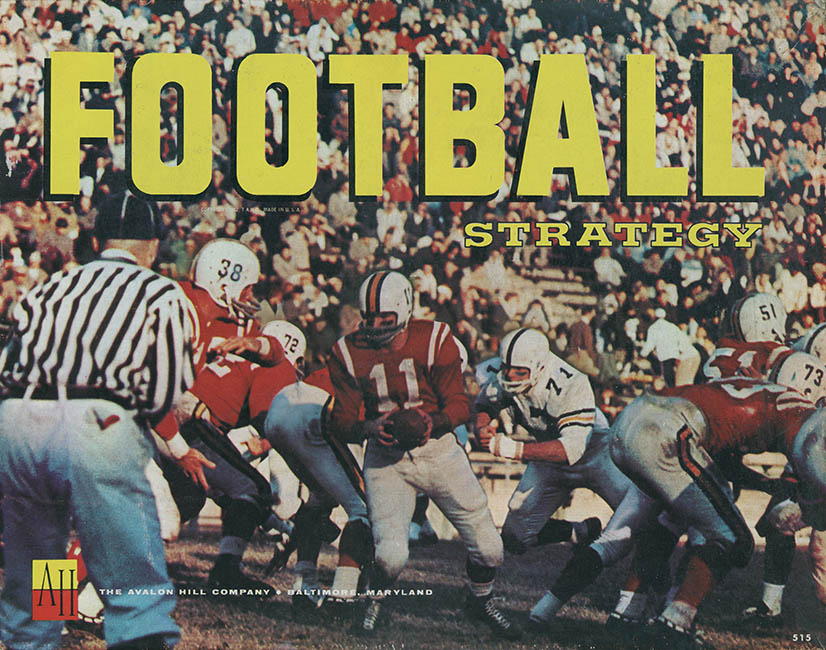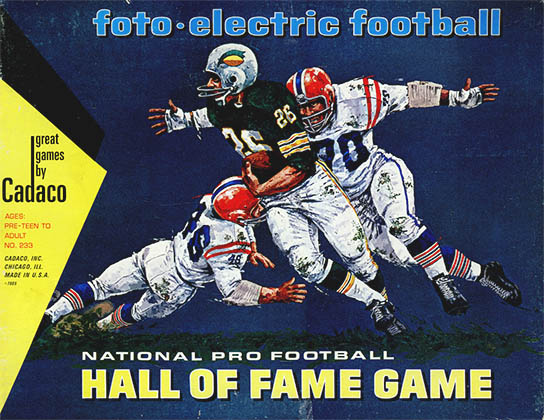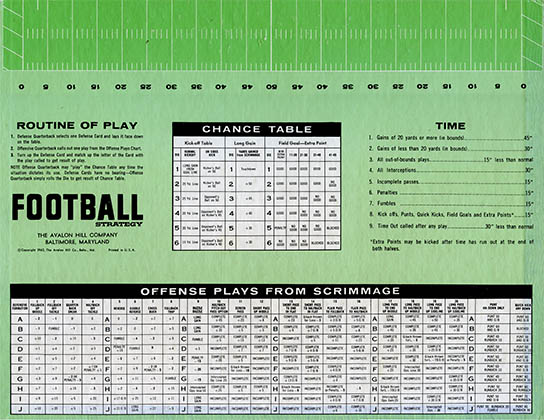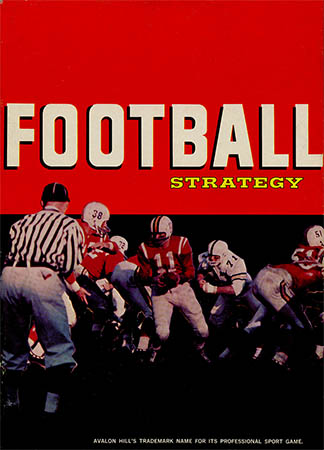100
Football Strategy
Perhaps the first board game to attempt to accurately simulate football was Elmer Layden’s Scientific Football designed by Donald J. Mazer of Cadaco in 1936. Although Mazer used the results of typical plays, the game (like all of Cadaco’s releases) relied heavily on the random outcomes of spinners and dice.
Mazer, a football enthusiast, followed up with several more titles that were essentially permutations of Layden. Touchdown was released in 1937, Varsity in 1938 and All-American Football in 1958.
His breakthrough title, however, was Foto-Electric Football, released in 1941. The game (in addition to the dice and spinners) included diagrammed play cards for both offense and defense which were placed into a light box. A slider was slowly removed to reveal the progression of the play. In actual play the game yielded little variation in outcomes but nevertheless it was the first classic football game and was the state-of-the-art for the next 20 years.
Foto-Electric Football, Cadaco, 1965
In 1958 Thomas N. Shaw, a former guided-missile repairman and copywriter formed the appropriately-named Strategy Game Company and released his first title - Football Strategy. Paul Stewart, writing in Sports illustrated, called it “the best football game ever invented.”1
Football Strategy, however, received little attention until Charles Roberts of the now mythical Avalon Hill bought not only the rights to the game but Shaw’s entire company. He even hired Shaw as a vice-president.2
In 1962 AH released a new, cleaned-up and more graphically professional version:
One-half of the original Football Strategy board. The other half is an exact mirror image
The mechanics of the game were simple. A player picked a card representing one of 10 defensive formations and the other called out one of 20 different offensive plays. Results were then cross-indexed on a table. A die roll was used only on kickoffs and field goals.3 The result was a cat-and-mouse system of outguessing the psychology of your opponent.
Football Strategy, Avalon Hill, 1966
Football Strategy, Avalon Hill, 1981
Aside from adding new charts (a ball control and aerial offense), the game remained essentially unchanged until it went out of print in 1998.4 The simple matrix format was the basis of hundreds of titles since. It would become, as Stewart suggested in 1961, the most important football game ever published.

1. Stewart, Paul. “Shopwalk.” Sports Illustrated. 11 Dec 1961, p. E1. The entire issue is available from the awesome SI Vault.
2. Avalon Hill released all three of Shaw’s early games, Football Strategy, the companion Baseball Strategy and Air Empire, a title which has been compared to filling out your 1040A long-form manually w/o the aid of a calculator. In 1962, when AH was facing bankruptcy, Roberts turned over the entire company to his largest creditor - the printer Monarch Services. Shaw was the only original employee retained by the new Monarch Avalon Printing.
3. Specifically a d6 (a cube). There also exists a d4 (tetrahedron), d8 (octahedron), d10 (pentagonal trapezohedron), d12 (dodecahedron) and d20 (icosahedron). As you could guess, you humble narrator’s intimate knowledge of this subject meant that he wasn’t getting laid much as an teen.
4. In 1998 Monarch sold Avalon Hill to Hasbro, the destroyer of game companies, and most of its back catalog, including Football Strategy was dropped. AH probably deserves it’s own post in which we can review this in more detail.
13 Aug 2011 ‧ Design





